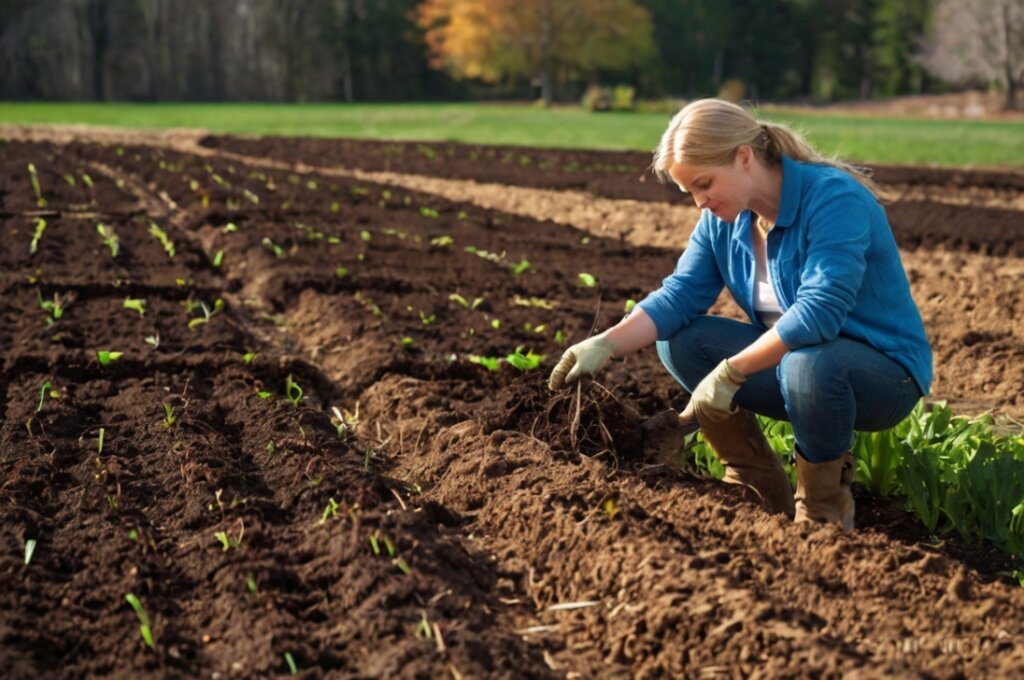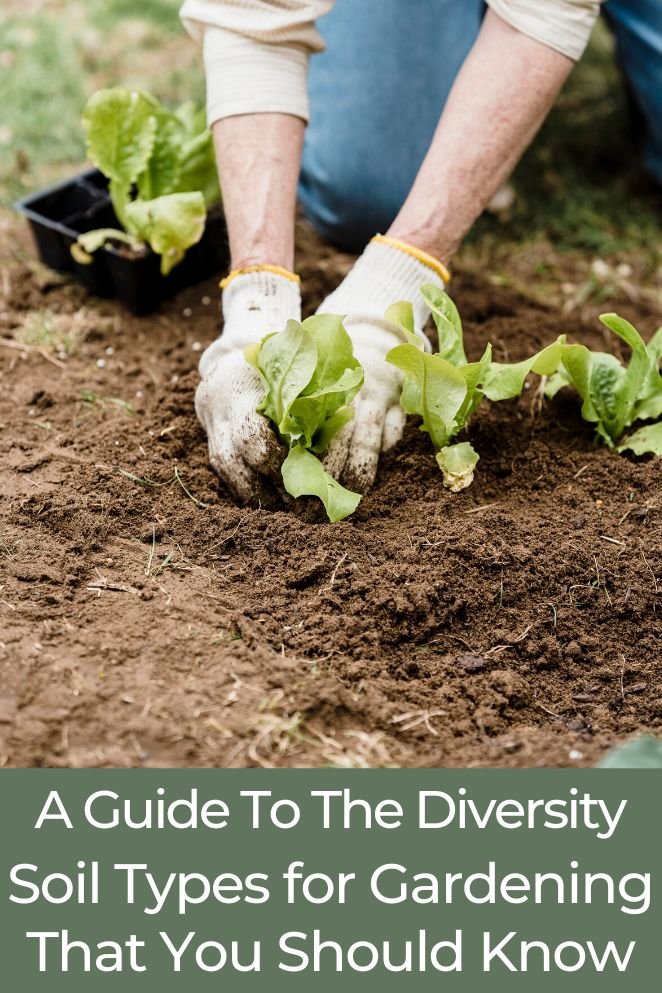
Greetings, gardening enthusiasts!
Soil, it’s more than mere dirt; it’s a varied universe, each type possessing unique powers to foster our cherished plants.
Join us as we delve into the captivating realm of soil types and their profound impact on the success of our gardens.
Plant Growth in Different Types of Soil
Successful gardening hinges on comprehending the diverse soil types, each wielding distinct qualities that significantly influence plant development.
Whether it’s clay, sand, silt, or loam, every soil variation boasts specific textures, drainage capacities, and nutrient compositions.
For instance, clay soil tends to retain water well but can become compacted, potentially suffocating plant roots.
On the other hand, sandy soil drains quickly, which can be beneficial for some plants but might lead to rapid nutrient leaching.
Silt soil is often fertile but prone to compaction, affecting root development.
Loamy soil, considered the gold standard, strikes a balance between drainage and moisture retention while offering good nutrient levels for a variety of plants.
Understanding these soil characteristics helps gardeners select the right plants that thrive in specific soil types.
It also guides soil amendments and management practices.
For example, amending clay soil with organic matter improves its drainage, while adding compost to sandy soil enhances its nutrient content.
In essence, comprehending soil types enables gardeners to work with nature rather than against it, fostering healthier plants and more productive gardens.
- Read also: Mastering the Art of Drip Irrigation for Tomatoes
- Read also: Different Types of Drip Irrigation Emitters
Soil with Its Own Unique Properties
Clay soil

Clay soil is fine-grained and feels smooth when dry. When wet, it becomes sticky and molds easily, often retaining its shape when squeezed.
Characteristics of clay soil
- Dense and compact: Clay soil particles are closely packed together, resulting in poor drainage and reduced aeration. Its density can lead to soil compaction, limiting root penetration and hindering plant growth.
- Moisture retention: It holds water well, making it prone to becoming waterlogged during heavy rain. Excessive water retention can suffocate plant roots and cause root rot in some species.
- Nutrient-rich: Despite its challenges, clay soil contains essential nutrients beneficial for plant growth.
- Hard when dry: Clay soil becomes hard and difficult to work with when dry, making it challenging to cultivate.
Best plants suited for clay soil
| Plant | Explanation |
| Shrubs and trees | Plants with robust root systems, like flowering shrubs such as lilacs and hydrangeas, often thrive in clay soil.Trees like oaks, maples, and some fruit trees can adapt well to the moisture-retaining properties of clay soil. |
| Perennials and annuals | Some perennials such as astilbes, hostas, and daylilies tolerate clay soil conditions.Annuals like marigolds, cosmos, and snapdragons can also grow successfully in amended clay soil. |
Tips for improving clay soil for gardening
- Add organic matter: Incorporate organic amendments like compost, well-rotted manure, or leaf mold to improve clay soil’s structure. Organic matter enhances soil aeration, promotes microbial activity, and aids in nutrient availability.
- Mulching: Apply mulch around plants to prevent the soil’s surface from compacting and to retain moisture.
- Avoid working when wet: Clay soil should not be used when it’s too wet to prevent further compaction. Wait until it’s slightly moist but not overly saturated.
- Raised beds or containers: Consider raised beds or container gardening, which allows better control over soil quality and drainage for plants that struggle in clay soil.
Sandy soil
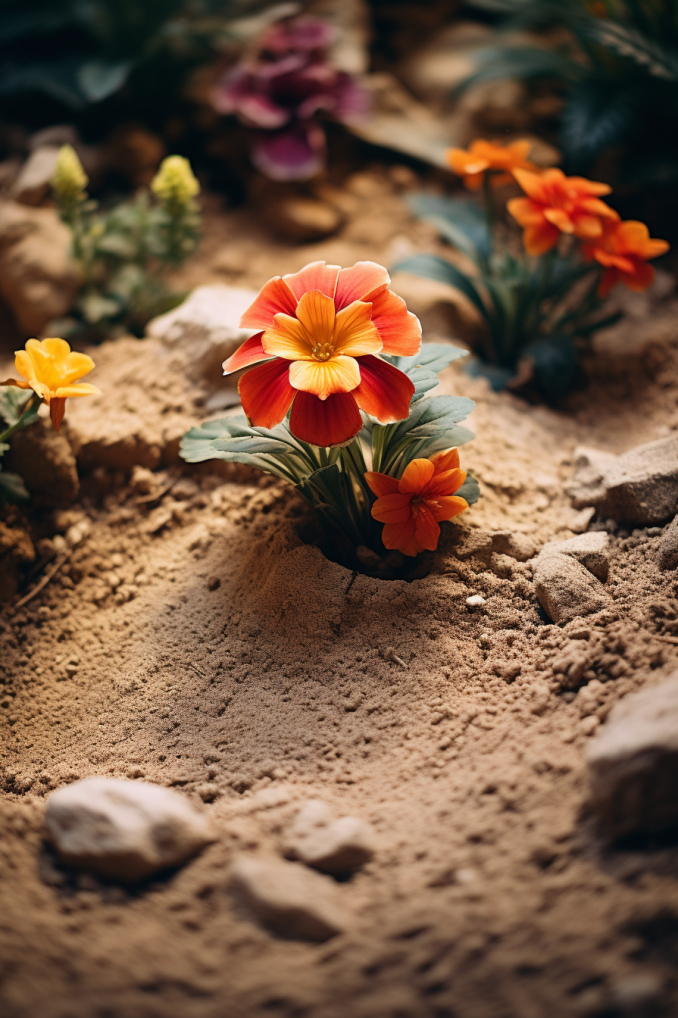
Characteristics of sandy soil
Sandy soil has distinct characteristics that influence gardening outcomes. Here’s a breakdown:
- Particle size: Sandy soil comprises larger particles compared to other soil types like clay or loam. These particles are visible to the naked eye. Some plants requiring strong anchorage might struggle due to the loose nature of sandy soil.
- Drainage: It offers excellent drainage due to its coarse texture, allowing water to pass through quickly. This can be advantageous in preventing waterlogging and prevents waterlogging, but can lead to faster drying out, requiring more frequent watering.
- Aeration: The larger particles create air spaces, enhancing aeration within the soil. Promotes healthy root development due to better oxygen circulation.
- Nutrient leaching: Sandy soil tends to have poor nutrient retention as water can easily carry away essential nutrients, requiring more frequent fertilization.
- Warmth: It warms up faster in spring, aiding early planting and germination.
Plants thriving in sandy soil
| Plant | Explanation |
| Cacti and succulents | These plants love the quick-draining nature of sandy soil. |
| Herbs | Rosemary, lavender, and thyme thrive in well-draining soil. |
| Vegetables | Carrots, radishes, and potatoes can do well with the loose texture. |
| Some annual flowers | Sunflowers, zinnias, and marigolds can flourish. |
Techniques to enhance sandy soil for gardening
- Organic matter addition: Incorporate compost, leaf mold, or well-rotted manure to improve nutrient retention.
- Mulching: Mulch with materials like straw or wood chips to reduce water evaporation and erosion.
- Cover cropping: Plants cover crops like clover or vetch to add organic matter and improve soil structure.
- Regular fertilization: As sandy soil tends to lose nutrients quickly, regular fertilization is crucial for plant health.
- Soil amendments: Adding materials like peat moss or coconut coir can help retain moisture.
Silt soil
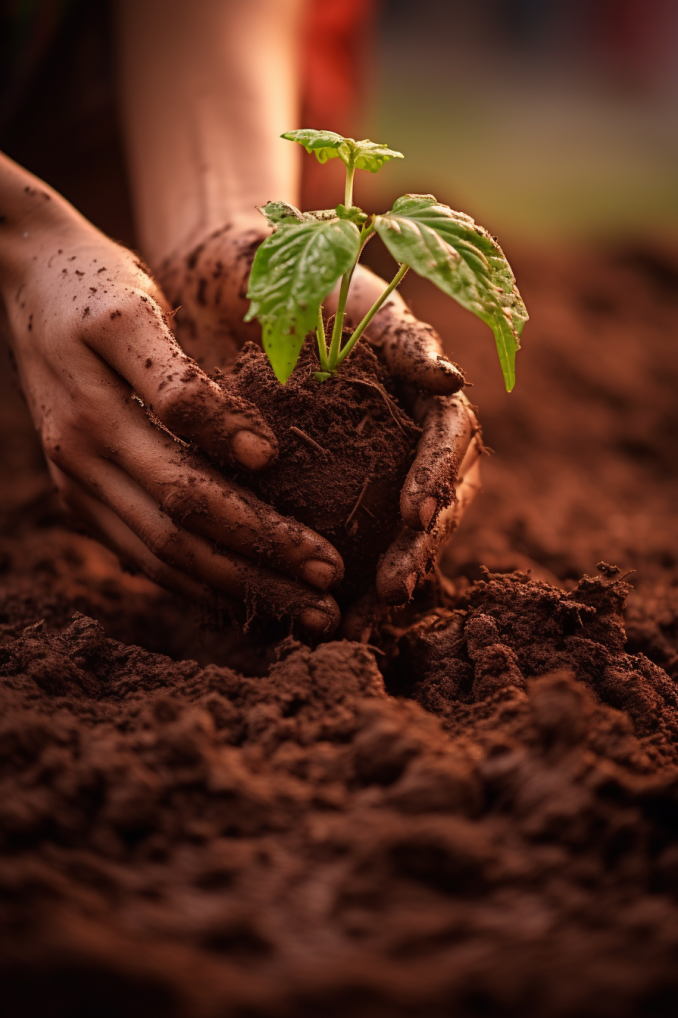
Characteristics of silt soil
Silt soil has unique characteristics and offers opportunities for gardening. Here’s a detailed breakdown:
- Particle size: Silt soil consists of fine particles, smaller than sand but larger than clay, giving it a smooth texture.
- Water retention: It retains water better than sandy soil but not as effectively as clay soil. It strikes a balance between drainage and water retention.
- Aeration: Silt soil provides adequate aeration due to its loose structure. Air pockets between the fine particles facilitate oxygen exchange, promoting healthy root development and overall plant growth.
- Compaction: It is prone to compaction when wet, hindering aeration and root growth.
- Fertility: Silt soil is naturally fertile due to the presence of minerals, making it suitable for various plants.
- Structure: Silt soil has a relatively stable structure, meaning the particles tend to clump together, forming aggregates. This structure enhances water retention and reduces erosion susceptibility.
- pH: Silt soil typically exhibits a neutral pH level, ranging from 6.5 to 7.5. This neutral pH suits a diverse range of plants, as it doesn’t pose any significant challenges for nutrient uptake.
- Drainage: Silt soil exhibits moderate drainage, allowing water to percolate through the soil at a balanced rate. This characteristic makes silt soil suitable for a wide range of plants, as it prevents waterlogging while retaining sufficient moisture.
Plants thriving in silt soil
| Plant | Details |
| Leafy greens | Spinach, lettuce, and kale thrive in silt soil due to its fertility. |
| Flowering plants | Roses, lilies, and irises can flourish in the balanced moisture levels of silt soil. |
| Vegetables | Beans, peas, and tomatoes can do well in this soil type. |
| Shrubs and trees | Some fruit trees like apples and pears can grow in silt soil. |
Utilizing silt soil effectively in gardening
- Improving drainage: Adding organic matter like compost or peat moss can enhance drainage, preventing waterlogging.
- Avoiding compaction: Minimize walking or heavy machinery on wet silt soil to prevent compaction.
- Mulching: Apply mulch to retain moisture and prevent erosion, especially on slopes or exposed areas.
- Crop rotation: Practice crop rotation to maintain soil fertility and reduce the risk of diseases specific to certain plants.
- Soil testing and amendments: Regularly test the soil pH and nutrient levels to determine necessary amendments for optimal plant growth.
- Terracing and contouring: If dealing with erosion, creating terraces or contouring the land can help slow down water runoff and prevent soil loss.
Loamy soil
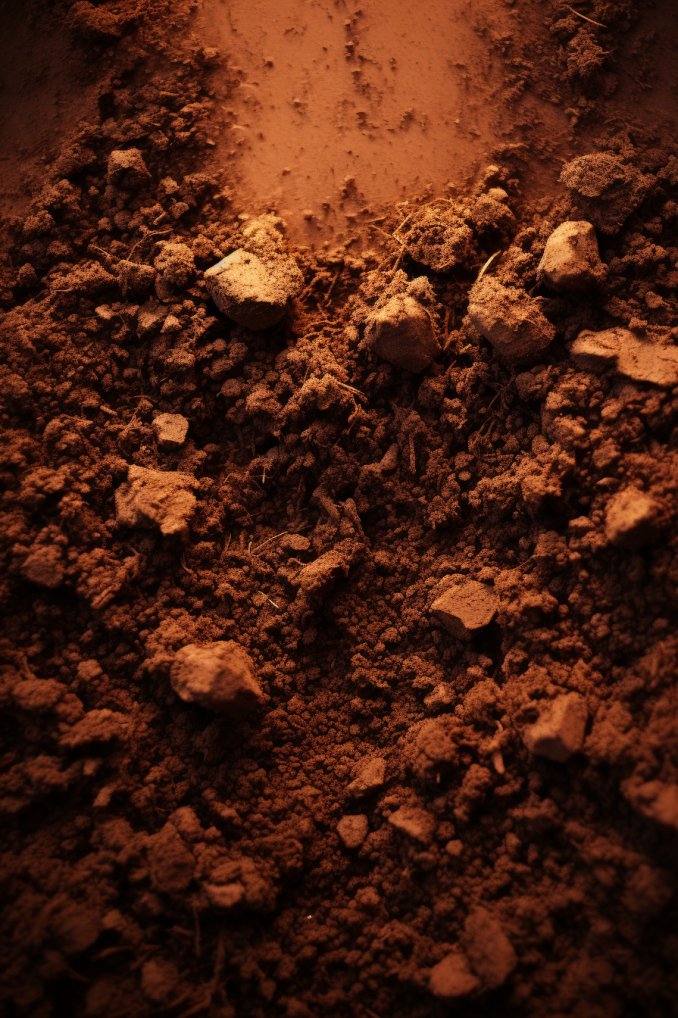
What sets loamy soil apart and earns it the title of the “gold standard” in gardening?
Let’s explore its exceptional traits that make it the perfect habitat for thriving plants, captivating any gardening enthusiast.
Characteristics of loamy soil
The perfect blend
Loam is a unique combination of sand, silt, and clay. Imagine a magical soil cocktail where each ingredient plays a crucial role:
- Sand: Think of sand as the drainage champion. Its large, gritty particles allow water to flow freely, preventing waterlogging and promoting healthy root development.
- Silt: This component acts like a tiny sponge, soaking up and retaining water, ensuring plants have access to moisture when needed. It’s the “water reservoir” of the soil.
- Clay: This sticky, fine-grained ingredient acts as the glue, holding everything together and providing structure to the soil. It also helps with nutrient retention.
In loamy soil, these ingredients exist in a near-perfect ratio – roughly 40% sand, 40% silt, and 20% clay. This magical combination creates soil with outstanding characteristics.
Excellent drainage
Loam’s excellent drainage prevents water from accumulating and becoming stagnant. This prevents root rot and other fungal diseases that thrive in wet environments.
Moisture Master
While it drains well, loamy soil also retains enough moisture to keep plants hydrated. The silt particles act like sponges, absorbing and releasing water as needed.
Nutrient-rich
The balanced composition of loam allows it to hold and release nutrients effectively. Clay’s ability to bind nutrients ensures they are readily available for plant uptake.
Friable texture
Loam has a crumbly, friable texture that makes it easy to cultivate and work with. Unlike clay, it doesn’t get hard and compacted, making gardening a joyful experience.
Root haven
The loose and aerated structure of loamy soil provides ample space and oxygen for roots to grow deep and strong. This leads to stable and healthy plants that can withstand harsh conditions.
Versatility champion
Loamy soil stands out as a versatility champion among soil types. Its adaptability spans a vast array of plants, accommodating everything from vegetables and flowers to trees and shrubs with ease.
A living ecosystem
Within loamy soil thrives a rich ecosystem teeming with diverse microorganisms, including bacteria and fungi. These minuscule inhabitants serve a crucial function by decomposing organic matter, unlocking nutrients, and enhancing the overall health of the soil.
Plants thriving in loamy soil
Numerous plants flourish in loamy soil due to its balanced texture and nutrient-rich composition. Here are for the example:
| Plant | Details |
| Vegetables | Tomatoes, peppers, and carrots |
| Flowers | Roses, lilies, and tulips |
| Fruits | Strawberries, blueberries, and apples |
| Shrubs and trees | Azaleas, rhododendrons, maple, and oak trees |
| Herbs | Basil and parsley |
Enhancing loamy soil in your garden
- Regular testing: Periodically test the soil to monitor its composition and pH levels.
- Adding organic matter: Incorporate compost, leaf mold, or well-rotted manure to improve soil structure and nutrient content.
- Aeration: Loosen compacted soil by aerating it regularly with a garden fork or mechanical aerator, allowing better airflow and water penetration.
- Mulching: Apply organic mulch like straw or wood chips to regulate soil temperature, reduce water evaporation, and enhance organic matter as it decomposes.
- Avoid overworking: While enhancing soil, avoid excessive tilling, as it can disrupt the natural structure and balance of the soil.
- Crop rotation: Rotate crops to prevent soil depletion and maintain fertility.
Peat soil
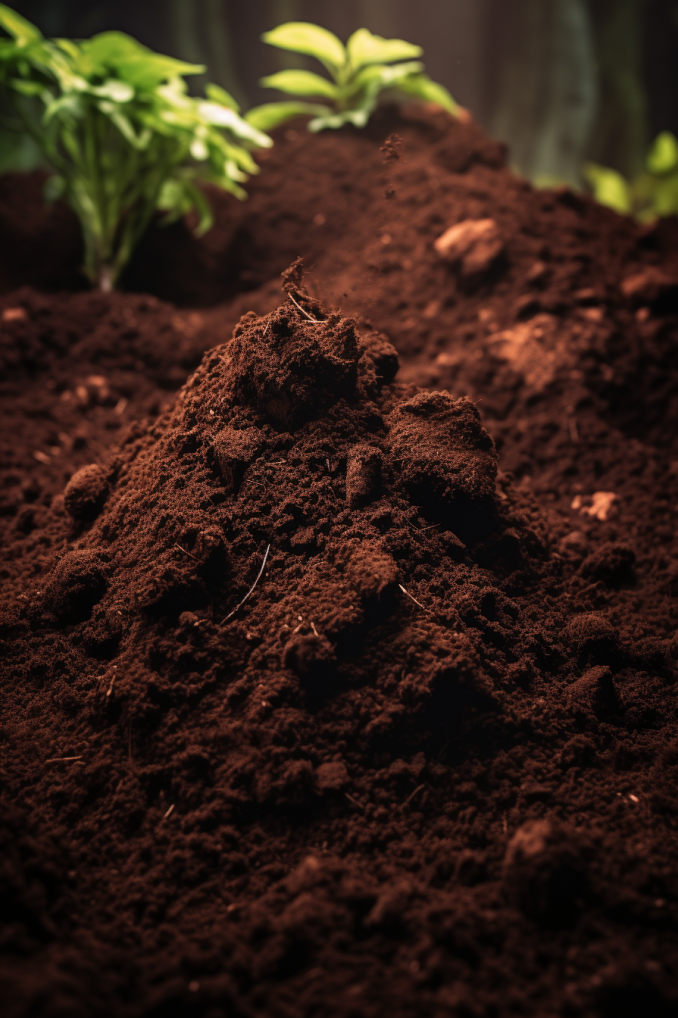
Peat soil, often referred to as peat moss or bog soil, develops in wet, acidic environments where organic matter decomposes at a slow pace.
This soil type predominantly comprises decayed plant material.
Characteristics of peat soil
- Acidic nature: Peat soil tends to be highly acidic, which can influence plant growth and nutrient availability.
- High organic content: Its richness in organic matter provides excellent moisture retention and contributes to its spongy texture.
- Water retention: Peat soil retains water exceptionally well due to its structure, making it valuable in retaining moisture for plants.
- Low bearing capacity: Peat’s weak structure and low-density result in a low bearing capacity. This means it cannot support heavy loads and is prone to deformation.
- Medium to low permeability: Peat has moderate water permeability, allowing water to move through it slowly. This is due to the small pore size within the organic matter.
- Low nutrient content: Peat naturally lacks vital nutrients such as nitrogen, phosphorus, and potassium, yet it can harbor elevated levels of carbon and various organic compounds.
Plants well-suited for peat soil conditions
| Plant | Details |
| Heath plants | Species like heather, rhododendrons, and azaleas thrive in acidic, well-drained conditions, making peat soil an ideal medium for their growth. |
| Carnivorous plants | Varieties like sundews and pitcher plants prefer the acidic, nutrient-poor environment that peat soil provides. |
| Certain vegetables | Some vegetables, like potatoes and carrots, can tolerate peat soil if the acidity is moderated and supplemented with necessary nutrients. |
Tips for improving clay soil for gardening
- Mixing with other soils: Combining peat soil with garden soil or other amendments helps balance its characteristics, improving drainage and nutrient content.
- Adding lime: To moderate acidity, adding lime can help make peat soil more suitable for a wider range of plants.
- Regular monitoring: Continuously assess the pH levels and nutrient content of the soil when using peat, ensuring it meets the needs of your plants.
- Adding fertilizer: Supplementing with fertilizers or compost is often necessary for balanced plant growth. While rich in organic matter, peat soil lacks certain essential nutrients.
Chalky soil
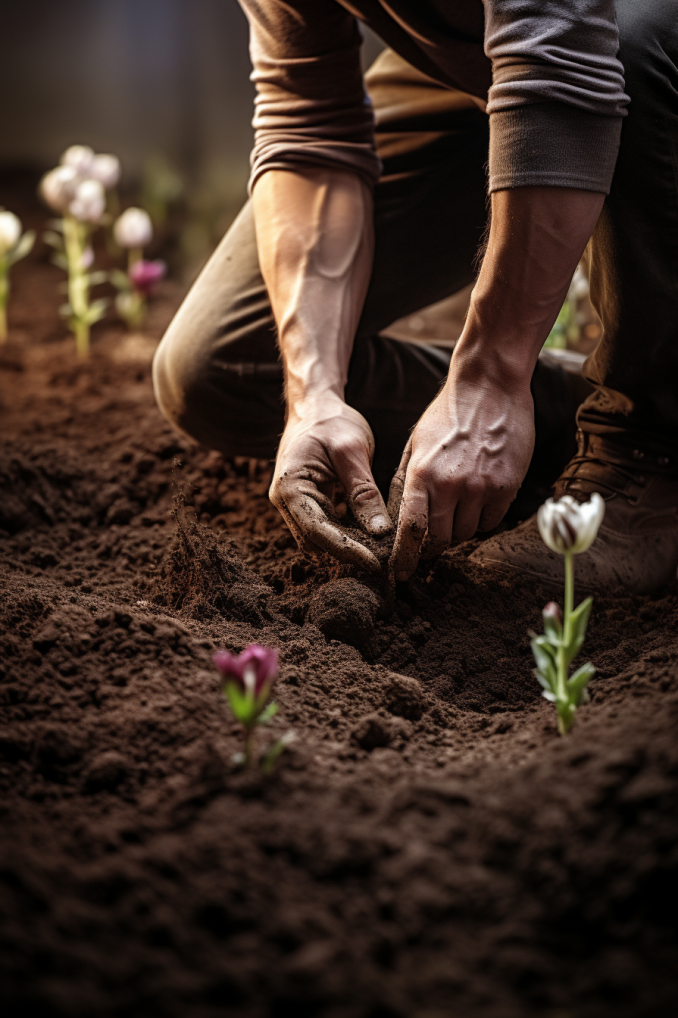
Chalky soil, also known as alkaline soil, originates from limestone and chalk deposits. It tends to be light and stony, with a high pH level.
Distinctive features of chalky soil
- Alkaline nature: Chalky soil is characterized by its high alkalinity, which affects nutrient availability and plant growth.
- Drainage: Its porous nature allows for excellent drainage, preventing waterlogging and supporting root aeration.
- Stony texture: Chalky soil often contains fragments of limestone or chalk, contributing to its gritty texture.
Types of plants that thrive in chalky soil
| Plant | Details |
| Alpine plants | Species like saxifrage, gentians, and alpine strawberries flourish in the well-drained, alkaline conditions of chalky soil. |
| Mediterranean herbs | Herbs such as lavender, thyme, and rosemary thrive in the alkaline environment of chalky soil, producing aromatic foliage and vibrant flowers. |
| Some wildflowers | Plants like cowslips and harebells can adapt well to the nutrient-poor but well-drained nature of chalky soil, displaying delicate blooms. |
Techniques for enriching chalky soil for gardening
- Adding organic matter: Incorporate organic materials like compost or well-rotted manure to improve moisture retention and enhance nutrient levels.
- Mulching: Applying organic mulch helps regulate soil temperature, reduce moisture loss, and gradually enrich the soil as it breaks down.
- Adjusting pH: To lower the pH, you can add acidic amendments like peat moss, coffee grounds, or sulfur. Be sure to test your soil regularly to avoid over-acidifying.
- Choosing suitable plants: Select plants that naturally thrive in alkaline conditions to ensure successful growth without extensive soil modification.
- Regular monitoring: Continuously assess soil pH and nutrient levels. Regular testing helps maintain an optimal environment for plant growth.
Improving drainage:
- Raised beds: Creating raised beds with a mixture of soil, compost, and sand can improve drainage and root growth.
- Drainage ditches: If your garden has poor drainage, consider digging ditches to divert excess water away from planting areas.
- Deep tillage: Breaking up the underlying chalk layer can improve drainage, but this should be done carefully to avoid damaging the soil structure.
Saline soil

Saline soil, also known as salt-affected soil, contains a high concentration of soluble salts.
The excess salt in the soil can negatively impact plant growth by affecting water uptake.
Characteristics of Saline Soil
- Salt buildup: Accumulation of salts, such as sodium chloride, in the soil.
- Poor water infiltration: Reduced water penetration due to salt-induced soil structure changes.
- Stunted plant growth: Excess salts can inhibit nutrient absorption, leading to stunted growth.
Plants Well-Suited for Saline Soil Conditions
| Plant Name | Adaptations for Saline Soil |
| Salicornia europaea | Thrives in high salt concentrations, often found in saline areas. |
| Suaeda maritima | Salt-tolerant succulent, suitable for saline environments. |
| Atriplex halimus | Resilient shrub adapted to saline soil conditions. |
Volcanic soil
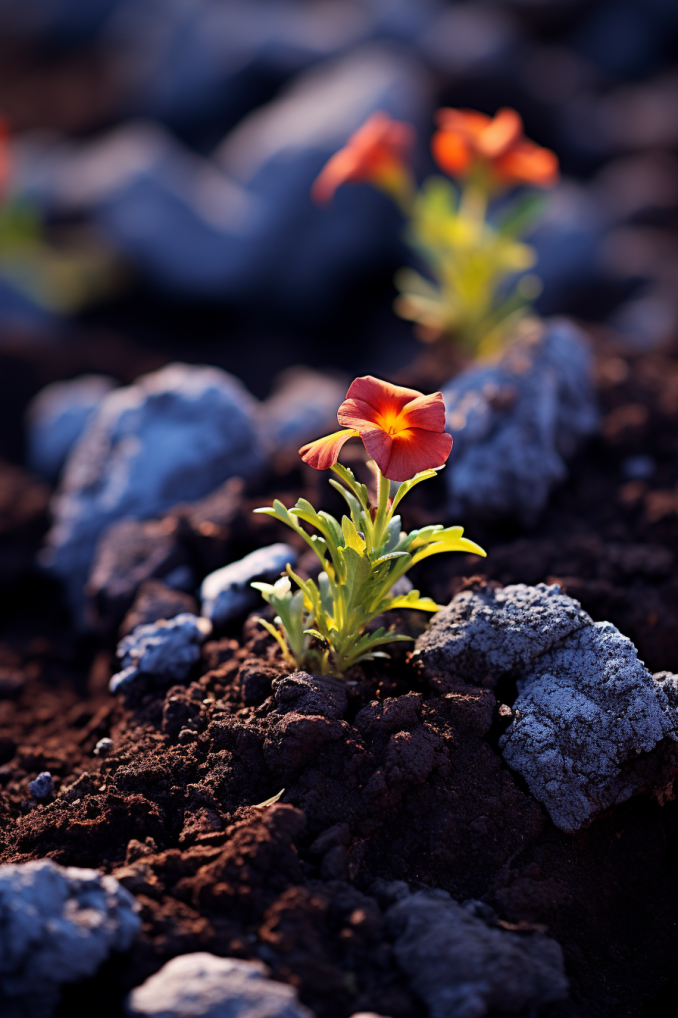
Volcanic soil, or volcanic ash soil, originates from the weathering of volcanic rocks. It is rich in minerals and nutrients, making it highly fertile.
Characteristics of Volcanic Soil
- Mineral-rich composition: Abundance of minerals like potassium, phosphorus, and trace elements.
- High porosity: Volcanic soil has good drainage properties due to its coarse texture.
- Fertility: Excellent fertility due to the presence of volcanic ash.
Plants Well-Suited for Volcanic Soil Conditions
| Plant Name | Adaptations for Volcanic Soil |
| Coffee Arabica | Flourishes in well-draining volcanic soil, ideal for coffee plantations. |
| Pineapple | Thrives in acidic volcanic soil conditions. |
| Anthurium andraeanum | Prefers the rich, well-aerated environment of volcanic soils. |
How to Find Out The Type of Soil
Feel test
Determining the type of soil involves a few straightforward methods.
One common approach is the “feel test,” where you take a small amount of soil and rub it between your fingers.
Sandy soil feels gritty and doesn’t hold its shape well.
Clay soil feels sticky and forms a tight ball when moistened. Loamy soil, which is a balanced mix of sand, silt, and clay, feels smooth and holds its shape without being overly sticky.
Jar test
Fill a jar with a soil sample and water, shake it vigorously, then let it settle. The layers that form indicate the soil composition.
Sand settles at the bottom, followed by silt, and clay stays suspended for a longer time, forming a top layer.
Soil pH testing
Soil pH testing kits are also available at garden centers or can be done through soil laboratories.
This test determines the acidity or alkalinity of the soil, which affects plant growth.
Plant observation
Observing plant growth in the area can offer clues as well.
Different plants thrive in different soil types. Plants like cacti and succulents prefer sandy soil, while azaleas and rhododendrons prefer acidic soil.
Consulting soil surveys or agricultural offices
Consulting soil surveys or local agricultural extension offices can provide detailed information about soil types in a specific region.
These sources often contain maps and descriptions of soil characteristics based on comprehensive analyses.
- Read also: Inorganic vs Organic Fertilizers
- Read also: Guide on How to Use Soil Conditioner
Conclusion
The foundation of successful gardening lies in understanding the subtleties of soil.
By grasping its individual characteristics, we gain the ability to cultivate flourishing gardens.
Embracing the distinct qualities of your soil enables you to collaborate with it, coaxing the finest outcomes from your plants.
Keep in mind that every soil type offers its advantages, and by tending to it with care, you can nurture a thriving haven for greenery.
FAQs
While you can’t fundamentally change soil type, you can improve it by adding amendments like compost to enhance its qualities.
Plants like azaleas, rhododendrons, and certain varieties of roses thrive in clay soil due to its moisture-retaining abilities.
It’s recommended to test your soil annually, especially if you’re experiencing growth issues or before planting new crops.

